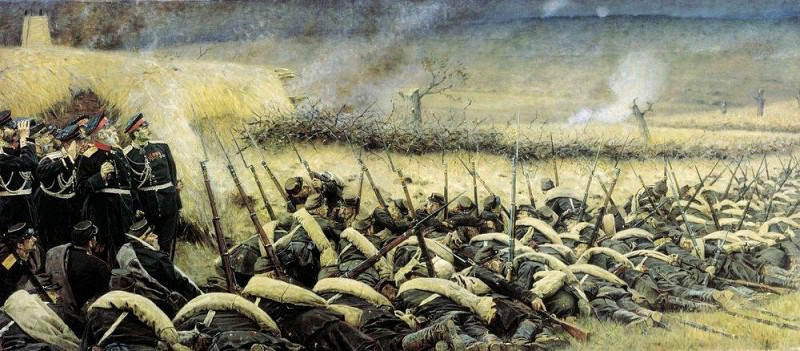before attacking. Plevna. 1881 Vasily Vereshchagin (1842-1904)
Vasily Vereshchagin – before attacking. Plevna. 1881
Edit attribution
Download full size: 1000×438 px (0,1 Mb)
Painter: Vasily Vereshchagin
Vereshchagin’s oeuvre would be incomplete if it lacked a series of Balkan works. It includes the painting Before the Attack. At Plevna", which dates back to 1881. It is an illustration of an attack by Russian soldiers on Turkish soldiers. The viewer is presented with a whole rank of soldiers, which is placed diagonally. There seems to be no end to its limit. These are soldiers whose caps, rifles and boots form a unity that is ready to go into battle.
Description of Vasily Vereshchagin’s painting "Before the Attack. At Plevna."
Vereshchagin’s oeuvre would be incomplete if it lacked a series of Balkan works.
It includes the painting Before the Attack. At Plevna", which dates back to 1881. It is an illustration of an attack by Russian soldiers on Turkish soldiers.
The viewer is presented with a whole rank of soldiers, which is placed diagonally. There seems to be no end to its limit. These are soldiers whose caps, rifles and boots form a unity that is ready to go into battle. And after the battle, the same unity will disintegrate into white and red patches that will heal the wounds received. In the distance you can see smoke coming from one of the attacks.
On the left side stand the officers, who are deprived of the main role on this canvas. The main characters here are the soldiers, many of whom will face the same thing that happened to the torn trees on the canvas.
In the painting "Before the Attack. At Plevna" the artist wanted to show the enormity of what was happening. It was this painting that would outrun cinematic tapes on military subjects. Thanks to the panoramic solution of this painting, the artist was able to achieve expressiveness of the image, which was noted by the audience.
It wasn’t easy for Vasily Vereshchagin to create this canvas. He repeatedly tried to tear or burn it. The artist worked around the clock on the picture. He literally slept with brushes and deprived himself of communication with his comrades while creating the canvas.
The picture was not appreciated by the master’s colleagues. They felt that the artist’s writing is too generalized, and the coloring lacks integrity.
Кому понравилось
Пожалуйста, подождите
На эту операцию может потребоваться несколько секунд.
Информация появится в новом окне,
если открытие новых окон не запрещено в настройках вашего браузера.
You need to login
Для работы с коллекциями – пожалуйста, войдите в аккаунт (open in new window).




















You cannot comment Why?
Behind them, a line of soldiers stretches into the distance, all in a similar defensive formation. The soldiers in the foreground are looking towards the right side of the frame, where smoke is rising, suggesting an enemy presence or the initial stages of an engagement. Two figures in more elaborate uniforms, likely officers, are in the upper left corner. One is looking through binoculars, while the other is surveying the scene with a stern expression.
The landscape is somewhat desolate, with dry grass and a few scattered trees. The sky is overcast, contributing to the somber and foreboding atmosphere. The overall impression is one of anticipation and the grim reality of war, highlighting the moments of stillness and reflection that precede violent conflict. The title, Before Attacking. Plevna. 1881, grounds the scene in a specific historical event, the Siege of Plevna during the Russo-Turkish War, evoking a sense of national pride and the sacrifices made by soldiers.